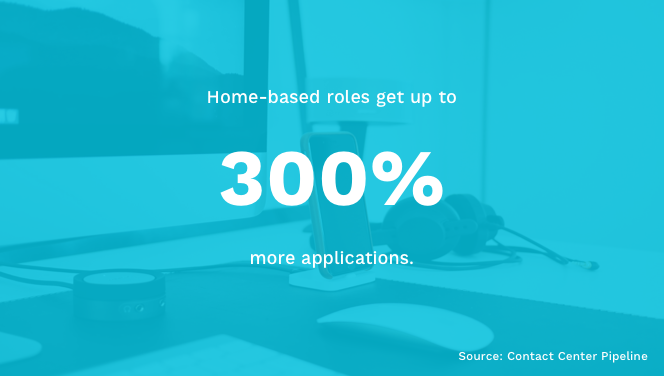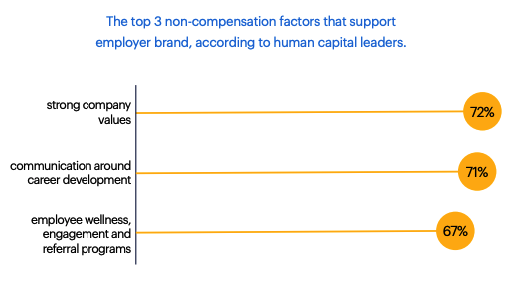Due to the spread of COVID-19 and regional lockdown laws, many contact centers have had to change how they work. Most notably, we’ve seen a shift towards remote working, which forced managers to quickly design and implement work-from-home policies. Not only that, but a lot of them had to juggle all this while handling a sudden spike in demand for their services. Unsurprisingly, this prompted many contact centers to hire new employees amid the lockdown, which is a whole new challenge in itself.
So how are you as a contact center or a BPO supposed to juggle the day-to-day administration that keeps you afloat, with the increasing complexity of hiring more staff?
Put crudely, if you want your recruitment processes to work in the post-COVID market, you’ll have to start making some changes…
If that sounds daunting, never fear. We’ve compiled a list of five changes contact center and BPO recruiters and hiring managers should consider making.
Let’s dive in!
What’s in?
Like what you see?
Don’t miss out. Subscribe to our quarterly digest to get the latest TA and TM resources delivered right to your inbox.
1. Looking for work-at-home candidate characteristics
It seems that remote work is here to stay for the contact centers and BPOs. Some employers are planning to increase their share of work-at-home agents by as much as 50%.
In one way, hiring a candidate for a remote role is no different from hiring one that will work alongside you in a contact center or office. After all, they’ll still need the skills and experience listed on the job spec, and you’ll still want to recruit the best of the bunch that applied. So, in these senses, not much has changed.
However, when your workforce (old and new) are working from home, with little (if any) supervision, there are a few characteristics and skills that make people successful in remote roles to look out for:
Integrity
Selecting candidates you can trust to follow your organization’s ways of working is essential. Your company’s priorities and KPIs won’t have changed, so a reliable candidate that doesn’t need constant micromanagement is paramount.
Planning and organization
Choose candidates who demonstrate planning and organizational skills, such as their ability to use their initiative to translate strategic aims into prioritized and operational tasks, and doing so independently.
High work standards
Look for candidates that evidence attention to detail and effective time management. Such high standards mean they’re less likely to be distracted by what’s going on around them. Ideally, you’re looking for a candidate whose tremendous work standards and deliverables don’t deviate, whether in the office or working remotely.
Problem analysis
Candidates that can analyze complex situations and resolve them without you being on-site to sort small issues are an added bonus to any remote team.
Teamwork
Remote employees need to work independently and as part of a team, collaborating with colleagues even when not at the same location. So, look for candidates who possess excellent communication and conflict resolution skills.
Self-development
Candidates who exhibit a desire to learn, act on feedback, and work hard to overcome their weaknesses are a positive choice for a remote team. Namely, because they can overcome challenges, are self-motivated, and ambitious without needing to be in the office.
Customer orientation
Candidates who can demonstrate impeccable customer service skills, including empathy, a friendly manner, and flexibility will be an asset to any remote contact center team. You can trust them to get the job done without standing over them.
This is an overview, but there’s plenty more detail on essential competencies remote workers should exhibit and ways of assessing these to explore – check out the full article here.

If you want to hire the best home-based contact center agents, you need to assess them for remote work competencies in an effective way.
2. Designing an effective virtual recruiting process
As a result of the ongoing coronavirus crisis, companies worldwide have started hiring candidates without ever meeting them face-to-face. And while some contact centers and BPOs with active work-at-home programs have been doing it already, it is a new reality for many of them.
Consequently, video interviewing has become essential in every recruiter’s toolbox.
But what else can you do to ensure your virtual recruiting process is as efficient and effective as possible?
Here are a few ideas:
Implement effective candidate assessments
When you’re handling increase volumes of candidates, you need to find ways to gather as much data about their skills before the interview process as you can.
Beside the common cognitive ability assessment and personality questionnaire, you can test your candidates’ typing, data entry, and language skills.
You can also verify candidates’ level of spoken language before even meeting them in a remote interview. Conduct a spoken language assessment where a candidate reads a word, a sentence, or a short paragraph and the tech analyses their pronunciation, fluency, etc.
In the assessment process, make sure that the candidates can experience the role, too. Including a short job simulation, for example, a situational judgement test or a chat simulation assessment are great ways to show the applicants what the contact center job is about and allows them to decide whether they see themselves doing it or not.
Setting benchmarks for scores in each of the assessments and the overall score will help you spot the best candidates faster. Also, with the granular assessment data at hand, you can then best match them to roles within your contact center that compliment their skillset. For example, an applicant that lacks sales skills for an outbound sale position can turn out to be a perfect candidate for a customer support role.
Experience our best-in-class Live Chat Assessment first-hand!
Perfect for remote hiring, our live chat assessment makes it easier than ever to hire live chat agents. Candidates experience the job, while you get actionable data to drive hiring decisions.
Use data to your advantage
The data you collect throughout any recruitment campaign is, without a doubt, one of your most valuable resources. So, make the most out of it!
Setting the right recruiting KPIs and keeping track of the results on a visual dashboard will help you identify the areas of improvement.
For example, keep a record of which channels your candidates have used to get in touch with you – did they see an advert on social media? What about the job boards? Was it through word of mouth? Analyze the figures, learn from them, and let them direct your focus when another vacancy becomes available.
This helps to ensure your job ad gets maximum exposure, which, in theory, should provide a broader pool of applicants to choose from. Not, to mention, you’ll save money by focusing your resources on recruitment channels that have proven to provide fruitful results.
Hire better live chat agents, at scale.
Dive into the rise of live chat, the skills of top-performing agents, and how to best assess them to reduce attrition and guarantee top-notch customer service.

3. Marketing your organization
Amidst all the chaos right now, strengthening your employer brand probably isn’t at the top of your priority list. With unemployment rates being the highest they’ve been for a while, it seems everyone knows someone looking for a job. So you might be thinking, how hard could it be to hire even a handful of people, when there are so many searching?
Spoiler alert: This way of thinking is detrimental to your company for two reasons:
1. The candidates who applied for your vacancy will probably have applied for 10, maybe even 50 more like it. If you neglect your branding at a time like this, how will you convince candidates (who may have several job offers on the table by the end of their job hunt) that your company is the one they should work for?
2. High levels of unemployment mean candidates are more likely to take the first job they’re offered. However, you have to ask yourself: is this really the caliber of candidate you’re looking for?
Ideally, you want to hire people specifically interested in working for you. These high-quality recruits are more likely to spread the word about your ideas, your brand’s ethos, and attract like-minded talent. With employees like this on your team, over time, you’ll also benefit from reducing staff turnover – win-win!
The moral of the story? Use any extra time you have to focus on building and maintaining a robust employer brand. Publish blog posts, post short, snappy vlogs on social media, hit up Instagram to engage with as many people as possible, etc.

Your employer brand can give you a competitive advantage and help you differentiate yourself from other contact center and BPO employers. (Image source)
4. Fair hiring
Even though fighting bias has long been at the forefront of talent acquisition activities, the need for fair hiring practices has become even more prominent in the light of the Black Lives Matter movement, which put systemic racism and inequity issues in the spotlight.
Using relevant data and validated assessments to evaluate candidates during the recruitment process is a good first step to reducing bias from your recruitment process.
However, you must go further than that. Fairness should be built into your recruitment process from attraction to onboarding, for instance, through:
- Removing names from applications
- Educating hiring managers around hiring bias
- Standardizing interviews
- Assembling diverse hiring panels
- Setting SMART diversity and inclusion goals
The state of diversity recruiting in 2020
5. Remote onboarding
As you’ll probably know first-hand, contact centers experience proportionately higher staff turnover than other companies. So, one of the critical issues at a time like this is the induction and training of new staff.
When your team is operating remotely, you’re not on hand to take recent hires through all the essential documents and training they need to understand the role. Or, to talk them through the ins and outs of their specific duties yourself.
Therefore, it’s crucial you create a new remote onboarding process. This should include a tailored training scheme that purposefully meets the requirements of your remote staff.
You can even get your existing team to help! Have them write up their primary duties and responsibilities and the steps they need to follow to complete them. Work through all these processes until you have a definitive “how-to” guide for every job role in your contact center.
These handbooks should be simple, easy to understand, and produced digitally. That way, you can email them out or share them on a cloud-based app like Google Docs.
Giving everyone edit access to one massive document helps you create a company-wide guide while instilling a greater sense of cohesion amongst your team. The phrase, ‘killing two birds with one stone’ springs to mind.
Other ways you could adapt the induction phase of your recruitment process, include:
- Creating a pre-filmed video guide of the company and their role within it.
- Setting up a video conference using Google Meet or Zoom to officially welcome them on their first day and talk them through their core responsibilities.
- Organizing all the necessary equipment ahead of time; send out headsets, laptops, and everything else they need to do their job. Make sure this arrives before their start date. What could be worse on your first day than sitting down to work, only to find you don’t have the equipment and/or software you need to do the job justice?
- Scheduling frequent check-ins. Starting a new job is always a tad daunting. But, starting a job without anyone actually there to supervise and check you’re getting things right, is even more so. So, along with the detailed handbooks we just mentioned, arrange to check-in with your new hires every day to begin with. Continue to do this until they’ve fully settled in and got into the swing of things.
Are you ready to up your contact center hiring game post-COVID-19?
Traditional contact center recruitment processes won’t be enough to sustain the centers themselves during the aftermath of this year’s unprecedented coronavirus pandemic.
In light of that, it’s imperative you take the time to digitally transform your existing framework and to streamline it where possible.
However, speed can’t come at the expense of expediency or equity; so, work fast but work smart too. Make it your mission to build a brilliant team of diverse individuals who will keep your contact center in business no matter what the market throws at you next.
- White paper
Before you continue!
Don’t forget to grab your free copy of our white paper on contact center volume hiring in 2021. Learn about:
-
The challenges currently shaping the contact e
center recruitment space - How employers can navigate the new remote-first reality, and the role of technology in a future-proof recruitment process
- The four building blocks of a fully digital recruitment process



